
Lane Center for Computational Biology
School of Computer Science, Carnegie Mellon University
Generative Models for Super-Resolution Single Molecule
Microscopy Images of Biological Structures
Suvrajit Maji
August 2012
Ph.D. Thesis
The ultimate objective of any biological imaging method is to understand the underlying biology especially through observing, analyzing and understanding the structures. Biological imaging using conventional light microscopy is limited in resolution due to the diffraction barrier of light and hence obtaining the detailed structural information is difficult. Recently, there has been advancement in this field to break the resolution limit with several super resolutions microscopy methods based on localization of single molecules such as STORM, PALM, etc. which are evolving into important tools for structural biology. A catalog of molecular positions provides insight into underlying structures potentially at molecular length scales and demands computational approaches that utilize the inherent positional information to extract meaningful structural biology–scale information about cellular structures. These methods still suffer from localization of single molecules in 3-d and we show that there are imaging methods which can improve the localization of multiple distinct molecules in a cell in 3-D. Moreover, there are limitations for dynamic imaging with these methods, since dynamic structures require information from fewer positions (i.e. shorter time window) to minimize underlying motion. Hence, the datasets are inherently incomplete. Our aim is to provide an information bridge between super-resolution microscopy and structural biology by using generative models to get a "molecular length-scale" picture of cellular structures. We hypothesize that generative models can accurately reconstruct biological structures using less data and with better resolution and infer useful biological information such as characteristic lengths, orientation of filamentous structure, molecular distributions for proteins inside a cell.
207 pages
Return to:
SCS Technical Report Collection This page maintained by reports@cs.cmu.edu
School of Computer Science